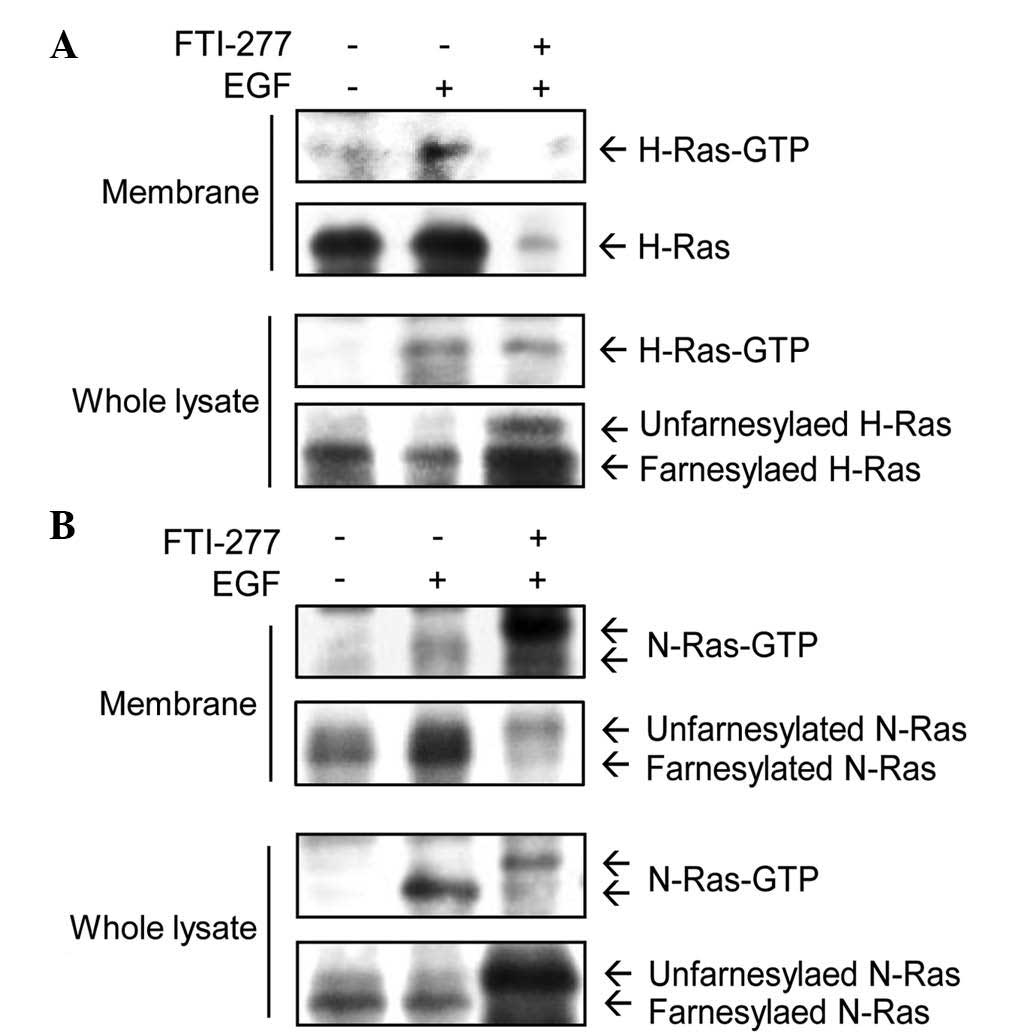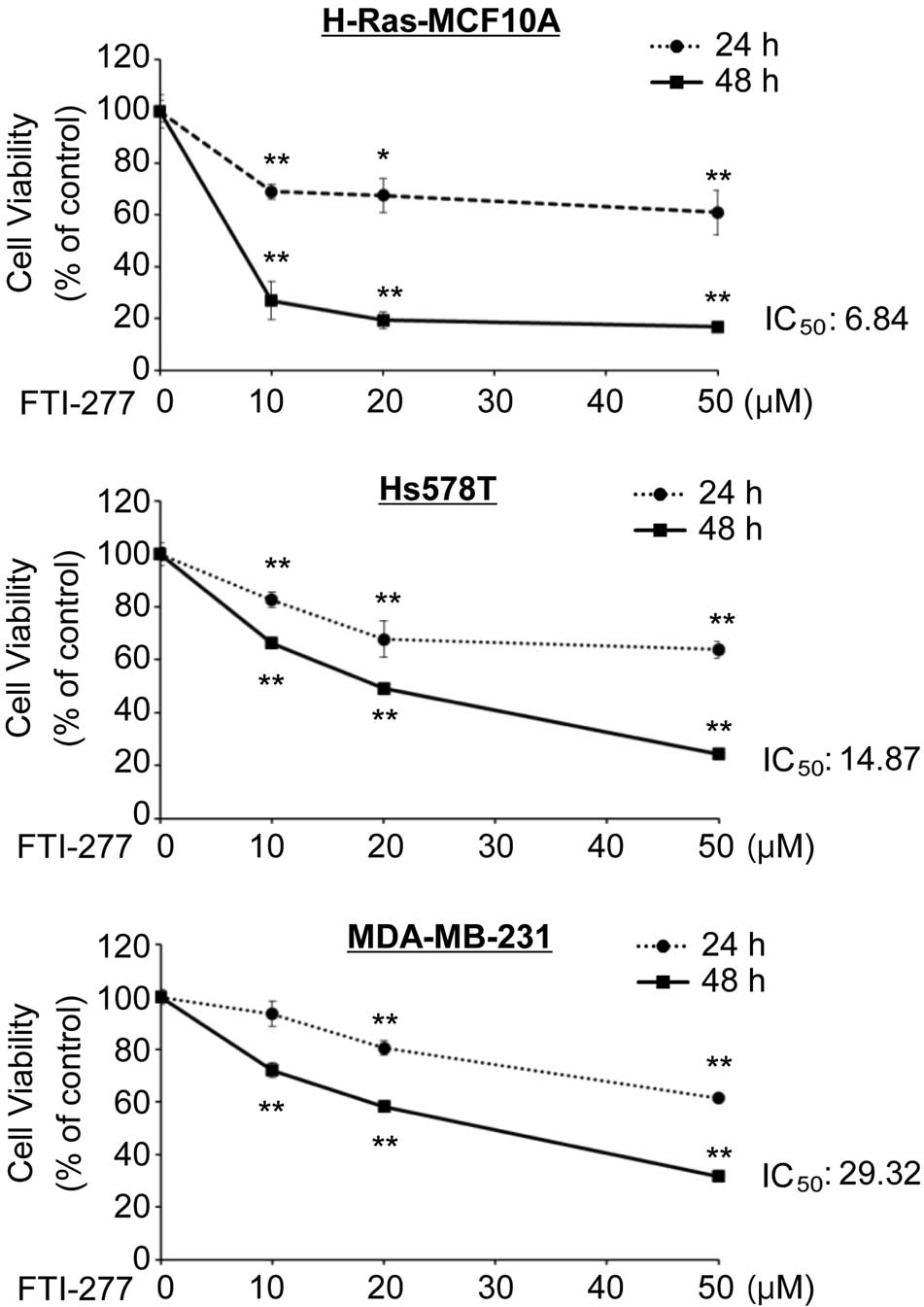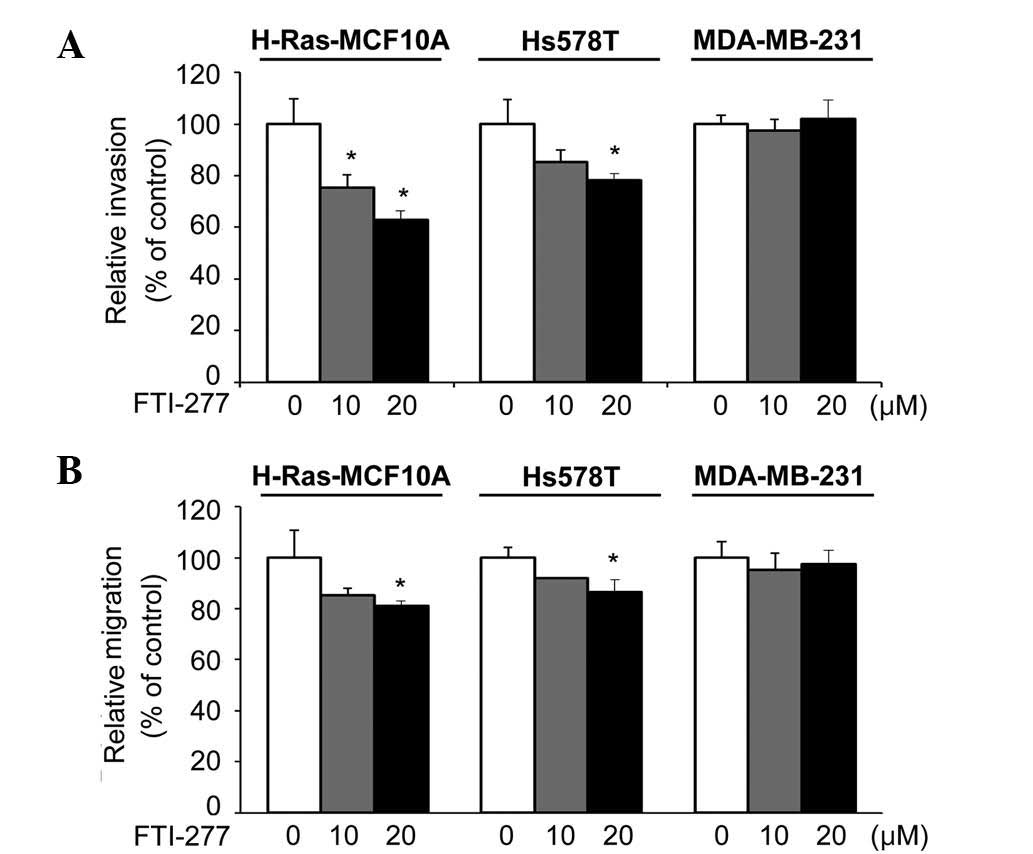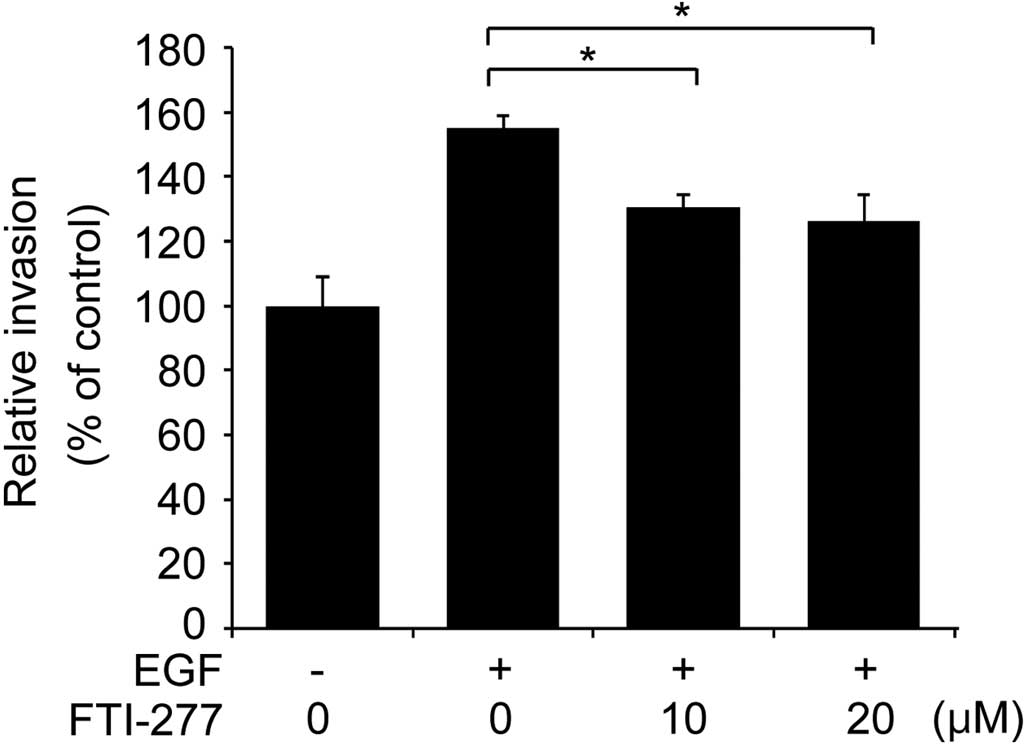|
1
|
Barbacid M: Ras genes. Annu Rev Biochem.
56:779–827. 1987. View Article : Google Scholar : PubMed/NCBI
|
|
2
|
Appels NM, Beijnen JH and Schellens JH:
Development of farnesyl transferase inhibitors: A review.
Oncologist. 10:565–578. 2005. View Article : Google Scholar : PubMed/NCBI
|
|
3
|
Carbone A, Gusella GL, Radzioch D and
Varesio L: Human Harvey-ras is biochemically different from
Kirsten- or N-ras. Oncogene. 6:731–737. 1991.PubMed/NCBI
|
|
4
|
Maher J, Baker DA, Manning M, Dibb NJ and
Roberts IA: Evidence for cell-specific differences in
transformation by N-, H- and K-ras. Oncogene. 11:1639–1647.
1995.PubMed/NCBI
|
|
5
|
Hancock JF and Parton RG: Ras plasma
membrane signalling platforms. Biochem J. 389:1–11. 2005.
View Article : Google Scholar : PubMed/NCBI
|
|
6
|
Reiss Y, Goldstein JL, Seabra MC, Casey PJ
and Brown MS: Inhibition of purified p21ras farnesyl: Protein
transferase by Cys-AAX tetrapeptides. Cell. 62:81–88. 1990.
View Article : Google Scholar : PubMed/NCBI
|
|
7
|
Cox AD, Der CJ and Philips MR: Targeting
RAS membrane association: Back to the future for Anti-RAS drug
discovery? Clin Cancer Res. 21:1819–1827. 2015. View Article : Google Scholar : PubMed/NCBI
|
|
8
|
Brunner TB, Hahn SM, Gupta AK, Muschel RJ,
McKenna WG and Bernhard EJ: Farnesyltransferase inhibitors: An
overview of the results of preclinical and clinical investigations.
Cancer Res. 63:5656–5668. 2003.PubMed/NCBI
|
|
9
|
Vasan N, Boyer JL and Herbst RS: A RAS
renaissance: Emerging targeted therapies for KRAS-mutated non-small
cell lung cancer. Clin Cancer Res. 20:3921–3930. 2014. View Article : Google Scholar : PubMed/NCBI
|
|
10
|
Liu M, Bryant MS, Chen J, Lee S, Yaremko
B, Lipari P, Malkowski M, Ferrari E, Nielsen L, Prioli N, et al:
Antitumor activity of SCH 66336, an orally bioavailable tricyclic
inhibitor of farnesyl protein transferase, in human tumor xenograft
models and wap-ras transgenic mice. Cancer Res. 58:4947–4956.
1998.PubMed/NCBI
|
|
11
|
Kohl NE, Omer CA, Conner MW, Anthony NJ,
Davide JP, deSolms SJ, Giuliani EA, Gomez RP, Graham SL, Hamilton
K, et al: Inhibition of farnesyltransferase induces regression of
mammary and salivary carcinomas in ras transgenic mice. Nat Med.
1:792–797. 1995. View Article : Google Scholar : PubMed/NCBI
|
|
12
|
Van Cutsem E, van de Velde H, Karasek P,
Oettle H, Vervenne WL, Szawlowski A, Schoffski P, Post S, Verslype
C, Neumann H, et al: Phase III trial of gemcitabine plus tipifarnib
compared with gemcitabine plus placebo in advanced pancreatic
cancer. J Clin Oncol. 22:1430–1438. 2004. View Article : Google Scholar : PubMed/NCBI
|
|
13
|
Cox AD, Fesik SW, Kimmelman AC, Luo J and
Der CJ: Drugging the undruggable RAS: Mission possible? Nat Rev
Drug Discov. 13:828–851. 2014. View
Article : Google Scholar : PubMed/NCBI
|
|
14
|
Lerner EC, Qian Y, Blaskovich MA, Fossum
RD, Vogt A, Sun J, Cox AD, Der CJ, Hamilton AD and Sebti SM: Ras
CAAX peptidomimetic FTI-277 selectively blocks oncogenic Ras
signaling by inducing cytoplasmic accumulation of inactive Ras-Raf
complexes. J Biol Chem. 270:26802–26806. 1995. View Article : Google Scholar : PubMed/NCBI
|
|
15
|
Siegel R, Ma J, Zou Z and Jemal A: Cancer
statistics, 2014. CA Cancer J Clin. 64:9–29. 2014. View Article : Google Scholar : PubMed/NCBI
|
|
16
|
Hudis CA and Gianni L: Triple-negative
breast cancer: An unmet medical need. Oncologist. 16(Suppl 1):
S1–S11. 2011. View Article : Google Scholar
|
|
17
|
Clair T, Miller WR and Cho-Chung YS:
Prognostic significance of the expression of a ras protein with a
molecular weight of 21,000 by human breast cancer. Cancer Res.
47:5290–5293. 1987.PubMed/NCBI
|
|
18
|
Moon A, Kim MS, Kim TG, Kim SH, Kim HE,
Chen YQ and Kim HR: H-ras, but not N-ras, induces an invasive
phenotype in human breast epithelial cells: A role for MMP-2 in the
H-ras-induced invasive phenotype. Int J Cancer. 85:176–181. 2000.
View Article : Google Scholar : PubMed/NCBI
|
|
19
|
Kim MS, Lee EJ, Kim HR and Moon A: p38
kinase is a key signaling molecule for H-Ras-induced cell motility
and invasive phenotype in human breast epithelial cells. Cancer
Res. 63:5454–5461. 2003.PubMed/NCBI
|
|
20
|
Shin I, Kim S, Song H, Kim HR and Moon A:
H-Ras-specific activation of Rac-MKK3/6-p38 pathway: Its critical
role in invasion and migration of breast epithelial cells. J Biol
Chem. 280:14675–14683. 2005. View Article : Google Scholar : PubMed/NCBI
|
|
21
|
Song H, Ki SH, Kim SG and Moon A:
Activating transcription factor 2 mediates matrix
metalloproteinase-2 transcriptional activation induced by p38 in
breast epithelial cells. Cancer Res. 66:10487–10496. 2006.
View Article : Google Scholar : PubMed/NCBI
|
|
22
|
Koh MS and Moon A: Activation of H-Ras and
Rac1 correlates with epidermal growth factor-induced invasion in
Hs578T and MDA-MB-231 breast carcinoma cells. Biochem Biophys Res
Commun. 406:25–29. 2011. View Article : Google Scholar : PubMed/NCBI
|
|
23
|
Lee HM and Moon A: Amygdalin regulates
apoptosis and adhesion in Hs578T triple-negative breast cancer
cells. Biomol Ther (Seoul). 24:62–66. 2016. View Article : Google Scholar : PubMed/NCBI
|
|
24
|
Kang S, Kim ES and Moon A: Simvastatin and
lovastatin inhibit breast cell invasion induced by H-Ras. Oncol
Rep. 21:1317–1322. 2009.PubMed/NCBI
|
|
25
|
Kim YT, Kim SK, Jeon YJ and Park SJ:
Seahorse-derived peptide suppresses invasive migration of HT1080
fibrosarcoma cells by competing with intracellular α-enolase for
plasminogen binding and inhibiting uPA-mediated activation of
plasminogen. BMB Rep. 47:691–696. 2014. View Article : Google Scholar : PubMed/NCBI
|
|
26
|
Peng Y, Zhong Y and Li G: Tubeimoside-1
suppresses breast cancer metastasis through downregulation of CXCR4
chemokine receptor expression. BMB Rep. May 9–2016.(Epub ahead of
print). PubMed/NCBI
|
|
27
|
Egan SE, Giddings BW, Brooks MW, Buday L,
Sizeland AM and Weinberg RA: Association of Sos Ras exchange
protein with Grb2 is implicated in tyrosine kinase signal
transduction and transformation. Nature. 363:45–51. 1993.
View Article : Google Scholar : PubMed/NCBI
|
|
28
|
Ehrhardt A, David MD, Ehrhardt GR and
Schrader JW: Distinct mechanisms determine the patterns of
differential activation of H-Ras, N-Ras, K-Ras 4B, and M-Ras by
receptors for growth factors or antigen. Mol Cell Biol.
24:6311–6323. 2004. View Article : Google Scholar : PubMed/NCBI
|
|
29
|
Kraus MH, Yuasa Y and Aaronson SA: A
position 12-activated H-ras oncogene in all HS578T mammary
carcinosarcoma cells but not normal mammary cells of the same
patient. Proc Natl Acad Sci USA. 81:5384–5388. 1984. View Article : Google Scholar : PubMed/NCBI
|
|
30
|
Hollestelle A, Elstrodt F, Nagel JH,
Kallemeijn WW and Schutte M: Phosphatidylinositol-3-OH kinase or
RAS pathway mutations in human breast cancer cell lines. Mol Cancer
Res. 5:195–201. 2007. View Article : Google Scholar : PubMed/NCBI
|
|
31
|
Prior IA and Hancock JF:
Compartmentalization of Ras proteins. J Cell Sci. 114:1603–1608.
2001.PubMed/NCBI
|
|
32
|
Oh SH, Kang JH, Kyu Woo J, Lee OH, Kim ES
and Lee HY: A multiplicity of anti-invasive effects of farnesyl
transferase inhibitor SCH66336 in human head and neck cancer. Int J
Cancer. 131:537–547. 2012. View Article : Google Scholar : PubMed/NCBI
|
|
33
|
Kusama T, Mukai M, Tatsuta M, Nakamura H
and Inoue M: Inhibition of transendothelial migration and invasion
of human breast cancer cells by preventing geranylgeranylation of
Rho. Int J Oncol. 29:217–223. 2006.PubMed/NCBI
|
|
34
|
Kusama T, Mukai M, Tatsuta M, Matsumoto Y,
Nakamura H and Inoue M: Selective inhibition of cancer cell
invasion by a geranylgeranyltransferase-I inhibitor. Clin Exp
Metastasis. 20:561–567. 2003. View Article : Google Scholar : PubMed/NCBI
|
|
35
|
Nam JS, Ino Y, Sakamoto M and Hirohashi S:
Ras farnesylation inhibitor FTI-277 restores the E-cadherin/catenin
cell adhesion system in human cancer cells and reduces cancer
metastasis. Jpn J Cancer Res. 93:1020–1028. 2002. View Article : Google Scholar : PubMed/NCBI
|
|
36
|
Denoyelle C, Hong L, Vannier JP, Soria J
and Soria C: New insights into the actions of bisphosphonate
zoledronic acid in breast cancer cells by dual RhoA-dependent and
-independent effects. Br J Cancer. 88:1631–1640. 2003. View Article : Google Scholar : PubMed/NCBI
|













